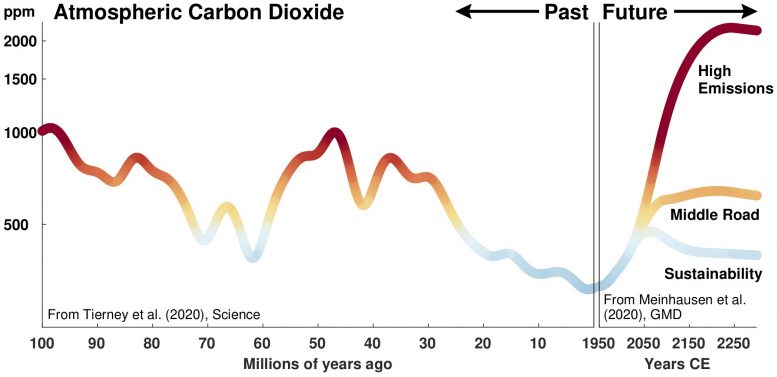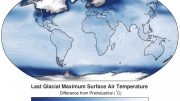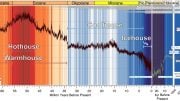
Past carbon dioxide concentrations (at left) compared to possible future emissions scenarios (at right): The rate of current emissions is much faster — occurring over decades — unlike geological changes, which occur over millions of years. If emissions continue unabated, carbon dioxide levels could meet or exceed values associated with past warm climates, such as the Cretaceous period (100 million years ago) or the Eocene epoch (50 million years ago), by the year 2300. Credit: Jessica Tierney/University of Arizona
Including paleoclimate data in the development of climate models could help climate scientists predict scenarios for future climate and propose strategies for mitigation.
An international team of climate scientists suggests that research centers around the world using numerical models to predict future climate change should include simulations of past climates in their evaluation and statement of their model performance.
“We urge the climate model developer community to pay attention to the past and actively involve it in predicting the future,” said Jessica Tierney, the paper’s lead author and an associate professor in the University of Arizona’s Department of Geosciences. “If your model can simulate past climates accurately, it likely will do a much better job at getting future scenarios right.”
As more and better information becomes available about climates in Earth’s distant history, reaching back many millions of years before humans existed, past climates become increasingly relevant for improving our understanding of how key elements of the climate system are affected by greenhouse gas levels, according to the study’s authors. Unlike historic climate records, which typically only go back a century or two — a mere blink of an eye in the planet’s climate history — paleoclimates cover a vastly broader range of climatic conditions that can inform climate models in ways historic data cannot. These periods in Earth’s past span a large range of temperatures, precipitation patterns, and ice sheet distribution.
“Past climates should be used to evaluate and fine-tune climate models,” Tierney said. “Looking to the past to inform the future could help narrow uncertainties surrounding projections of changes in temperature, ice sheets, and the water cycle.”
Typically, climate scientists evaluate their models with data from historical weather records, such as satellite measurements, sea surface temperatures, wind speeds, cloud cover, and other parameters. The model’s algorithms are then adjusted and tuned until their predictions mesh with the observed climate records. Thus, if a computer simulation produces a historically accurate climate based on the observations made during that time, it is considered fit to predict future climate with reasonable accuracy.
“We find that many models perform very well with historic climates, but not so well with climates from the Earth’s geological past,” Tierney said.
One reason for the discrepancies is differences in how the models compute the effects of clouds, which is one of the great challenges in climate modeling, Tierney said. Such differences cause different models to diverge from each other in terms of what climate scientists refer to as climate sensitivity: a measure of how strongly the Earth’s climate responds to a doubling of greenhouse gas emissions.
Several of the latest generation models that are being used for the next report by the Intergovernmental Panel on Climate Change, or IPCC, have a higher climate sensitivity than previous iterations, Tierney explained.
“This means that if you double carbon dioxide emissions, they produce more global warming than their previous counterparts, so the question is: How much confidence do we have in these very sensitive new models?”
In between IPCC reports, which typically are released every eight years, climate models are being updated based on the latest research data.
“Models become more complex, and in theory, they get better, but what does that mean?” Tierney said. “You want to know what happens in the future, so you want to be able to trust the model with regard to what happens in response to higher levels of carbon dioxide.”
While there is no debate in the climate science community about human fossil fuel consumption pushing the Earth toward a warmer state for which there is no historical precedent, different models generate varying predictions. Some forecast an increase as large as 6 degrees Celsius by the end of the century.
Tierney said while Earth’s atmosphere has experienced carbon dioxide concentrations much higher than today’s level of about 400 parts per million, there is no time in the geological record that matches the speed at which humans are contributing to greenhouse gas emissions.
In the paper, the authors applied climate models to several known past climate extremes from the geological record. The most recent warm climate offering a glimpse into the future occurred about 50 million years ago during the Eocene epoch, Tierney said. Global carbon dioxide was at 1,000 parts per million at that time and there were no large ice sheets.
“If we don’t cut back emissions, we are headed for Eocene-like CO2 levels by 2100,” Tierney said.
The authors discuss climate changes all the way to the Cretaceous period, about 90 million years ago, when dinosaurs still ruled the Earth. That period shows that the climate can get even warmer, a scenario that Tierney described as “even scarier,” with carbon dioxide levels up to 2,000 parts per million and the oceans as warm as a bathtub.
“The key is CO2,” Tierney said. “Whenever we see evidence of warm climate in the geologic record, CO2 is high as well.”
Some models are much better than others at producing the climates seen in the geologic record, which underscores the need to test climate models against paleoclimates, the authors said. In particular, past warm climates such as the Eocene highlight the role that clouds play in contributing to warmer temperatures under increased carbon dioxide levels.
“We urge the climate community to test models on paleoclimates early on, while the models are being developed, rather than afterwards, which tends to be the current practice,” Tierney said. “Seemingly small things like clouds affect the Earth’s energy balance in major ways and can affect the temperatures your model produces for the year 2100.”
Reference: “Past climates inform our future” by Jessica E. Tierney, Christopher J. Poulsen, Isabel P. Montañez, Tripti Bhattacharya, Ran Feng, Heather L. Ford, Bärbel Hönisch, Gordon N. Inglis, Sierra V. Petersen, Navjit Sagoo, Clay R. Tabor, Kaustubh Thirumalai, Jiang Zhu, Natalie J. Burls, Gavin L. Foster, Yves Goddéris, Brian T. Huber, Linda C. Ivany, Sandra Kirtland Turner, Daniel J. Lunt, Jennifer C. McElwain, Benjamin J. W. Mills, Bette L. Otto-Bliesner, Andy Ridgwell and Yi Ge Zhang, 6 November 2020, Science.
DOI: 10.1126/science.aay3701









“While there is no debate in the climate science community about human fossil fuel consumption pushing the Earth toward a warmer state for which there is no historical precedent,…”
The above is an assertion for which the facts are not in evidence. There are many well-known scientists who are more prestigious than the associate professor lead author of this article! It is absurd to claim that there is “no debate” on the issue of the role of anthropogenic CO2 in warming the Earth. Central to the contentious debate about the role of CO2 is what is known as the Equilibrium Climate Sensitivity (ECS). There is NO agreement on what the correct ECS is. There is a general consensus that there is a probable range of ECS that varies from negligible to catastrophic. That ‘consensus’ isn’t much more helpful than going to two fortune tellers and one telling you that you will win the lottery, and the other saying that you will NOT win the lottery!
Where there is little debate is the role of Milankovitch Cycles in causing the onset and periodic temporary suspensions of glaciation. Clearly, there was a low in global CO2 about 20,000 years ago that appears to be a result of the cold rather than the cause of the cold. Is it not reasonable that if the CO2 declined as the Earth got colder that it should subsequently increase as the Earth warms?
The author suggests that paleoclimate records should be incorporated in climate models, and cherry picks the Eocene as an example of high CO2 and high temperatures. Unlike her claim, taking the long-term view shows very little correlation between global temperatures and estimated CO2 levels. Antarctic ice core records strongly suggest that CO2 lags temperature changes by about 800 years.
The article says, “The rate of current emissions is much faster — occurring over decades — unlike geological changes, which occur over millions of years.”
That may be true. However, it is almost impossible to prove that claim because once the age of a sedimentary deposit is older than available tree rings, the error becomes a fraction of the age, and not simply countable. Worse yet, whatever the proxies are for CO2 and temperature, they can be diluted, diffused, and removed by sedimentation and the chemical processes that go on in buried sediments. The result is that time acts like what is called a low-pass filter, suppressing abrupt changes. So, it is possible that there have been events in the past when the rate of increase of CO2 were equal to or greater than today, but it would be difficult to measure because of the low-pass filter effect. Therefore, contrary to the author’s claim, there IS debate about “no historical precedent.”
When I was supervising a survey of a tunnel in the Greenland ice cap near Thule air base, we were sometimes interrupted by Danish air crews wanting some clean ice for their party drinks. That is because there was air entrapped in the ice that effervesced in the drinks as it melted. As glaciers melt, and expose the very oldest ice at the bottom of the sheet, they release air that has the composition of the atmosphere at the time snow fell at the location. That is, as melting proceeds, air with increasing percentages of CO2 are released back into the air, thus causing a spike in CO2 that nobody was around to measure thousands of years ago.